Boneyard Becomes Improvised Training Ground W&L’s strength and conditioning program adapts to the COVID-19 era.
“I think most of all, the workouts have provided a continued outlet for athletes to get outside and be with their respective teams.”
~ Coby Kirkland ’22
Tucked away in a distant corner of the Washington and Lee University campus lies the Boneyard, which normally serves as the home venue of throwing events for the men’s and women’s track and field programs.
Right now, though, it’s an improvised training ground set up by the Athletic Department’s strength and conditioning coaches.
Due to the COVID-19 pandemic, all W&L varsity athletic events are currently suspended. The university’s public health policies allow team activities, but typically prohibit traditional practices that would violate social distancing measures.
Yet thanks to the dedication and improvisation of the university’s strength and conditioning staff, the Generals should be in even better shape once they return to action.
W&L’s strength and conditioning coaches, Hayli Yetter and Aron Gibson, spent the spring and summer months devising an outdoor setup that would allow team training sessions while still complying with safety protocols.
“The biggest thing was trying to balance how to do strength and conditioning with our student-athletes, and balancing what the general population of Washington and Lee needed,” said Yetter, who just began her third year as W&L’s head strength and conditioning coach. “Thinking about the great weather that we have in Virginia, we could find a way to make strength and conditioning work outside if I could get a good chunk of space to do that.”
They settled on transforming the Boneyard into a makeshift outdoor facility. Going this route accomplished two things: It gives student-athletes more opportunities to train, and it allows the indoor Fitness Center – housed within W&L’s beautiful new Richard L. Duchossois Athletic and Recreation Center – to remain open to the campus at large.
Yetter’s role also includes working as director of the Fitness Center. But Patti Colliton, the assistant manager of the indoor facility, has taken on a bigger role there, freeing up Yetter for more direct involvement with the outdoor site.
The Boneyard currently features 60 individual workout stations. There are 40 tents that house sandbags, hurdles and cones, and homemade sleds; in between two rows of these tents lie 20 pull-up bars, with a plastic bucket providing the step-up.
Athletes must keep their face coverings on throughout their training sessions, and bottles of sanitizer are readily available across the field. A whiteboard sign near the parking lot reads: “Welcome to the Boneyard. Fill out your daily attestation. Bring your water bottle. Wear your mask at all times. GO HARD.”
Constructing the site was a campus-wide affair: The University Facilities carpentry shop built the pull-up bars. Gibson made the sleds with tarp, rope, a seatbelt and four levels of bands. Coaches from across the Athletics Department spent a socially distanced workday filling up sandbags.
Gibson joined the athletics staff last fall, serving as both assistant strength and conditioning coach and as the throws coach for men’s and women’s track and field. He’s been happy to help turn his home base into a temporary training site.
“The idea of coming out here where we could get 40 people at once, get more times through the lifts and everything, just makes it great,” Gibson said. “For the good of the university, and the space we have, and the resources we have, it was just a fantastic spot to be.”
W&L student-athletes are appreciative of how the Boneyard has allowed them to maintain at least one key portion of their training regimen.
“Coach Yetter and Coach Gibson have worked hard to find ways that we can stay in shape with limited equipment available,” said Coby Kirkland ’22, a slotback for the football team. “I think most of all, the workouts have provided a continued outlet for athletes to get outside and be with their respective teams.”
While Yetter and Gibson are accustomed to doing their jobs behind the scenes, their efforts certainly haven’t gone unnoticed – even beyond the student-athletes and coaches with whom they work directly.
“It’s hard to put a value on Coach Yetter’s and Coach Gibson’s contributions to this,” said Jan Hathorn, the Michael F. Walsh Director of Athletics. “They wholeheartedly believe in the work they do and in offering our student-athletes a fantastic opportunity to train, regardless of the ever-changing circumstances. [They are] just outstanding individuals doing outstanding work.”
Having the space and putting together the equipment was only part of the equation. Unorthodox class schedules and the unusual situation of having all W&L teams in some form of an offseason mean that Yetter and Gibson are rarely working with just one sport at a time. Instead, training sessions usually involve a combination of athletes from different teams.
That’s also necessitated a change of approach for their workout plans. Rather than designing programs for individual sports, the coaches have focused on the various components of athleticism and conditioning – and then applied those elements to what each team requires.
“We just tried to plug and play teams into what they needed, rather than writing for a team,” Yetter said. “A lot of people are doing similar things, but it’s still geared to what their sport demanded.”
There’s also one key element of strength and conditioning – and athletic competition in general – that never changes, regardless of the setting.
“Coach Yetter has always prioritized mental toughness, and I think this idea is even more important than ever, especially at the Boneyard,” said women’s lacrosse defender McKenna Edmonson ’22. “We really have to dig our heels in, be gritty, and be mentally tough every day – and know that, although these strength and conditioning workouts are atypical, they are going to be what sets us apart come [our] season.”
Much to the benefit of student-athletes across the board, Gibson and Yetter have encountered a difficult situation and tackled it head-on. What’s more, they seem to have embraced the challenges that come with working outside the confines of a traditional gym.
“This is literally that coming to fruition, where it’s here’s what you have, now make something of it,” Gibson said. “I love that idea, and I really love how it’s forcing us to expand our coaching abilities.”
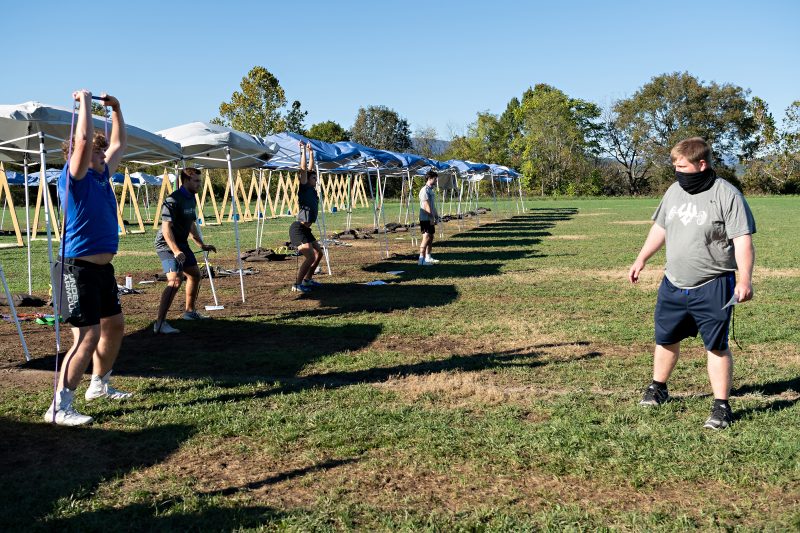 Assistant Strength and Conditioning Coach Aron Gibson works with student-athletes as they do strength-training exercises in the Boneyard.
Assistant Strength and Conditioning Coach Aron Gibson works with student-athletes as they do strength-training exercises in the Boneyard.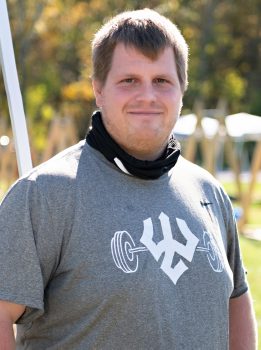 Coach Aron Gibson
Coach Aron Gibson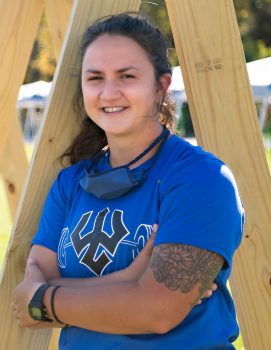 Coach Hayli Yetter
Coach Hayli Yetter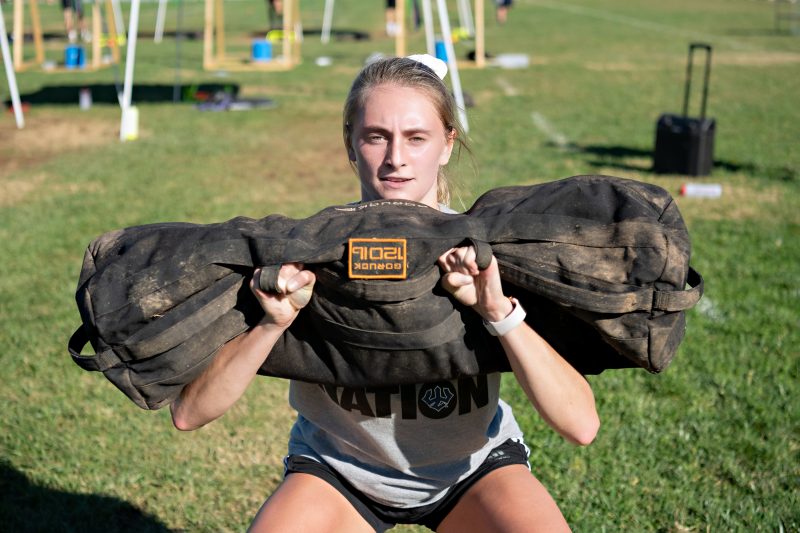 Volleyball player Brynne Gould ’21 works with a sandbag at the Boneyard.
Volleyball player Brynne Gould ’21 works with a sandbag at the Boneyard.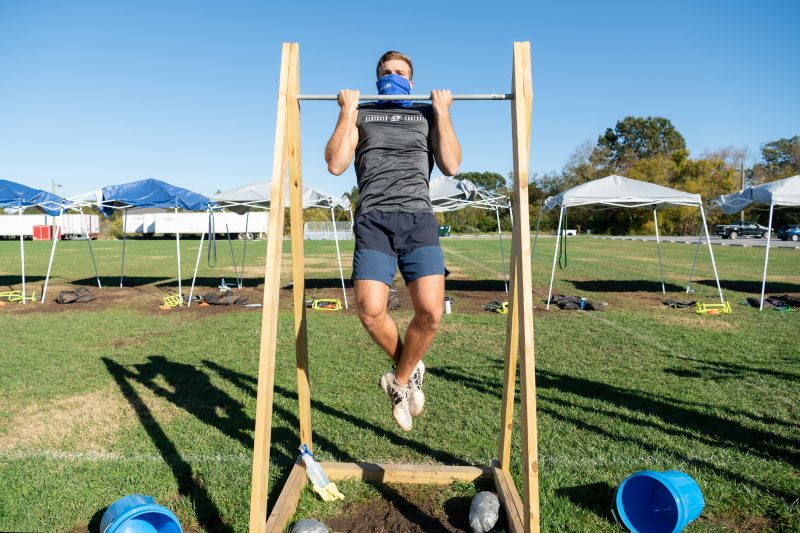 Football player Coby Kirkland ’22 does chin-ups in the Boneyard.
Football player Coby Kirkland ’22 does chin-ups in the Boneyard.
You must be logged in to post a comment.